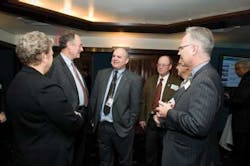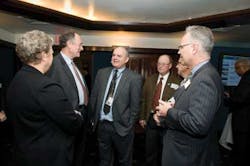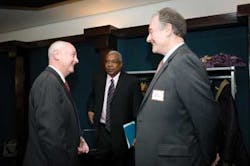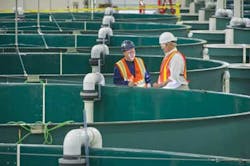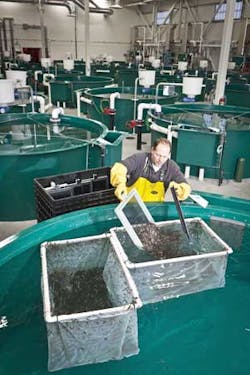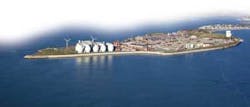Envisioning the Future: Rating System Helps Infrastructure Projects Meet Long-Term Sustainability Goals
By William Atkinson
When it comes to infrastructure sustainability improvement initiatives, there is a "new kid on the block," and it seems to be gaining traction nationwide. Called the Envision™ Sustainable Infrastructure Rating System, it is designed with two objectives in mind: to provide a holistic framework for evaluating and rating the community, environmental and economic benefits of all types and sizes of infrastructure projects; and to provide a basis for evaluating, grading and providing recognition to infrastructure projects that use transformational, collaborative approaches to assess the sustainability indicators over the course of a project's lifecycle.
Envision is the result of a joint collaboration between the Zofnass Program for Sustainable Infrastructure at the Harvard University Graduate School of Design and the Institute for Sustainable Infrastructure (ISI). The ISI is a 501(c)(3) not-for-profit organization that was founded by the American Council of Engineering Companies (ACEC), the American Public Works Association (APWA) and the American Society of Civil Engineers (ASCE).
When one thinks of rating systems pertaining to environmental issues, the first that likely comes to mind is LEED (Leadership in Energy & Environmental Design), created and managed by the U.S. Green Building Council. So, is Envision simply "LEED for infrastructure"? The answer is yes and no. "We see Envision and LEED as two sides of the same coin," said Bill Bertera, executive director of ISI. "LEED, of course, addresses buildings - so, a vertical emphasis. Envision addresses what we call 'horizontal infrastructure,' which includes just about everything except habitable buildings." One difference, however, according to Bertera, is that, while LEED tends to emphasize "green" projects, the focus of Envision is on sustainability as a whole - a much broader scope.
Who Can Use Envision
Envision can be used by infrastructure owners, design teams, community groups, environmental organizations, constructors, regulators, and policymakers to:
- Meet sustainability goals
- Be publicly recognized for high levels of achievement in sustainability
- Help communities and project teams collaborate and discuss ("Are we doing the right project?" and "Are we doing the project right?")
- Make decisions about the investment of scarce resources
- Include community priorities in civil infrastructure projects
Envision can be used by virtually all types of infrastructure organizations, including water and wastewater utilities, for all types of projects. "In fact, from the anecdotal information we have, I would estimate that almost half of the public entities using Envision are using it on water- and wastewater-related activities," said Bertera. "For example, the New York City Department of Environmental Protection is using it on several projects, including the Hannah Street Pumping Station, and the Massachusetts Water Resources Authority is planning to use it on some projects." Most of the anecdotal information ISI receives is from press releases, reports from consultants who are using the tool with public sector clients, and other sources. "However, there are a lot more entities using Envision that we don't even know about," he said.
Why isn't there more comprehensive and authoritative data on Envision projects? It is by design, according to Bertera. "Entities can use this tool without even telling us. One reason we did this is because the primary purpose of Envision isn't to hand out awards," he said. "Rather, it is to encourage public entities to use sustainable thinking in their planning, design, construction, and maintenance operations." Another reason that ISI allows anonymity is that it wants public entities to feel comfortable using Envision, such as being able to enter data and know that this information will be safe as a result of not having to report it to anyone.
Envision Tools
Tools provided by Envision help project design teams assess costs and benefits over the lifecycles of the projects, evaluate environmental benefits, use outcome-based objectives, and reach higher levels of sustainability achievement.
One of these is the Envision Checklist, an educational tool that helps users familiarize themselves with the sustainability aspects of infrastructure project design. The Checklist can be used as a stand-alone assessment to quickly compare project alternatives or to prepare for a more detailed assessment. It is organized into five categories, with 14 subcategories, totaling 60 sustainability criteria. The five categories are: Quality of Life, Leadership, Resource Allocation, Natural World, and Climate and Risk. The Checklist is structured as a series of Yes/No questions based on the Envision Sustainable Infrastructure Rating System, which is another tool that can be used by project teams to self-assess their projects or by ISI Verifiers (discussed below) for third- party objective reviews. Ultimately, using the Rating System may enable projects to become eligible for Envision awards. The Rating System includes a guidance manual and scoring system. Likewise, other Envision tools are currently being developed, including an economic optimization tool and construction and operations and maintenance (O&M) phase credits.
Currently, Envision offers two types of accreditation. One is an Envision Sustainability Professional (ENV SP), a person who is trained in the use of the Envision rating system and is credentialed by ISI. This individual is an integral part of the project team, guiding it toward achieving higher levels of sustainability, documenting project sustainability accomplishments and submitting the project for recognition.
The other is a Verifier, a person in an independent third-party firm who works with the ENV SP to validate his/her assessment of a project. "When an entity submits a project to us in order to be considered for an award, or for public recognition that a project has achieved a certain level of sustainability, we conduct an audit using a company that contains individuals who have been trained by ISI as Verifiers," said Bertera. "One reason we focus on companies rather than on individuals to conduct the audits is that we realize conducting evaluations of Envision projects likely requires more than a single skill set, and it is unlikely that a single Verifier who has been to our training program will have all of the skill sets necessary for the variety of projects that come our way."
Envision in Action
One organization starting to instate Envision is the Massachusetts Water Resources Authority (Boston). "We are a newcomer to the program," said Fred Brandon, assistant director of engineering. "We have four projects that we are just beginning to move forward with, and we have incorporated Envision into the planning process for these projects." The idea of using Envision at the MWRA came up in early 2013. "We were approached by the ISI, which explained Envision to us," he said. "It looked like a very interesting program, so we decided to have about ten of our staff members trained."
As noted earlier, Envision has five different categories and a number of subcategories. "We realized that we were already looking at many of these things as part of our ongoing process, such as impact on communities, cost-effectiveness and use of energy," said Brandon. "However, we felt that Envision could help us standardize and quantify the way we look at many of these criteria that we already include in evaluating our projects."
Given that the utility is still early in the process, Brandon admitted that it would be difficult to offer any "lessons learned" for other utilities. "The only thing I would suggest is that people take the training so they understand Envision and can apply it to future projects," he said. "This has been very helpful to us."
Perspective
"While we call Envision a 'rating system,' and certainly there is scoring associated with it, we expect that, in the future, it will be used primarily as a very powerful planning tool to ensure that projects take advantage of every technology and procedure that they can in order to be sustainable," said ISI's Bertera.
"In the public sector and engineering community, we are already doing a lot of things that meet the definition of sustainability," he continued. However, without using a tool like Envision and consciously thinking about sustainability, as projects come together, the likelihood of missing certain things is high. Envision provides a comprehensive approach and certainty to a sustainability commitment.
Bertera added one final detail about using the system: "Envision is applicable at any and all points in the lifecycle of a project," he said. Even if a project has been in operation for a period of time, it is certainly appropriate to embrace Envision along the way. There is no requirement that it be used from the very beginning.
For more information on Envision, visit the program's website at www.sustainableinfrastructure.org.
About the Author: William Atkinson is a correspondent for WaterWorld Magazine. He has been a full-time freelance business magazine writer since 1976, specializing in infrastructure, sustainability, supply chain, risk management, and safety/health.
